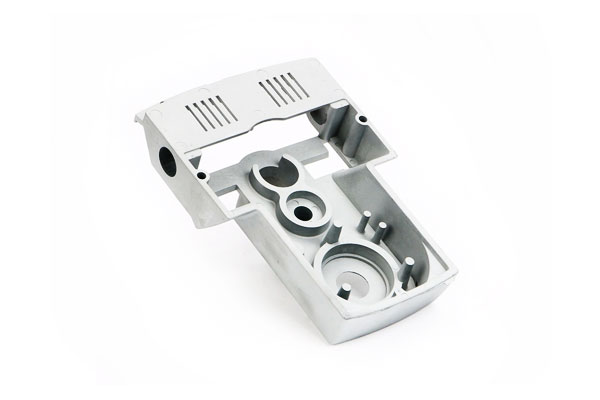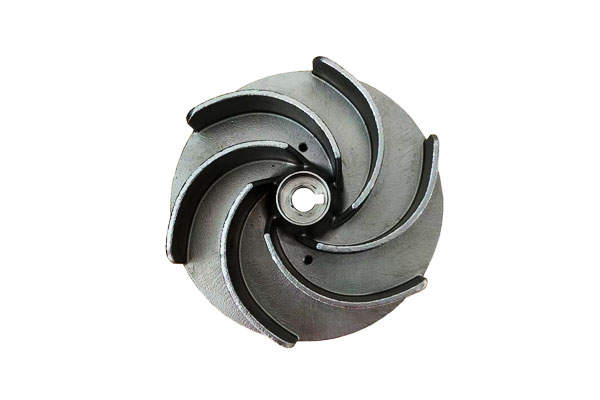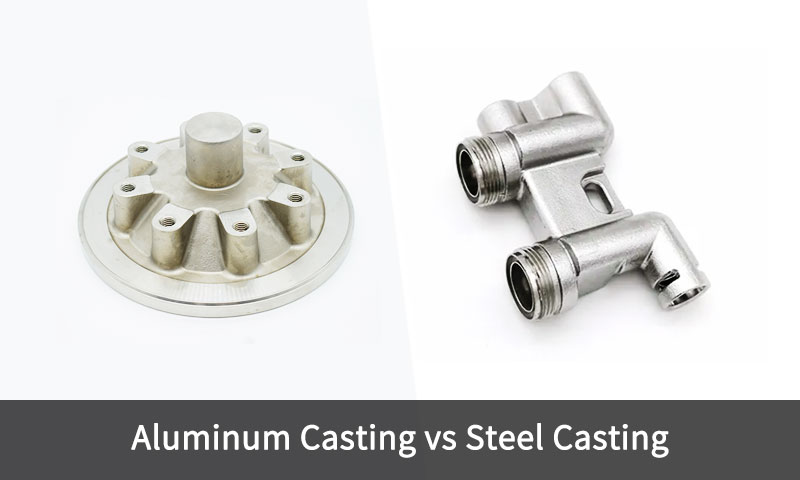1. Введение
Aluminum vs Steel Casting — choosing between these two foundational materials shapes component performance, cost and manufacturability across industries from automotive to energy.
This comparison is not merely about metal chemistry: it encompasses density and stiffness, тепловое поведение, casting process compatibility, secondary processing (термическая обработка, поверхностная инженерия), lifecycle cost and application-specific reliability.
Engineers and purchasers must therefore evaluate the entire system—loading, температура, environment, production volume and finish requirements—before specifying a metal and casting route.
2. Fundamental Material Differences Between Aluminum vs Steel
At the core of aluminum vs. steel casting lies a fundamental metallurgical and physical contrast that directly affects how each material behaves during casting, обработка, и сервис.
| Свойство | Алюминий (НАПРИМЕР., Аль-я ослабляет) | Сталь (НАПРИМЕР., carbon or low-alloy steels) | Инженерные последствия |
| Плотность (G/CM³) | 2.70 | 7.85 | Aluminum is ~65% lighter, offering major weight savings for transportation and aerospace. |
| Точка плавления (° C.) | 615–660 | 1425–1540 | Aluminum’s low melting point enables easier casting and lower energy consumption; steel requires specialized furnaces. |
| Теплопроводность (W/m · k) | 120–180 | 40–60 | Aluminum dissipates heat efficiently—ideal for engines, теплообменники, и электроника. |
| Конкретная сила (MPa/ρ) | ~100–150 | ~70–90 | Despite lower absolute strength, aluminum’s strength-to-weight ratio surpasses that of steel. |
| Эластичный модуль (Средний балл) | 70 | 200 | Steel is stiffer, providing better rigidity under load and vibration. |
Коррозионная стойкость |
Отличный (forms Al₂O₃ layer) | Переменная; prone to rust without coatings | Aluminum resists oxidation naturally, while steel needs surface protection (рисование, покрытие, or alloying with Cr/Ni). |
| Механизм | Отличный | От умеренного или трудного | Aluminum’s softness allows easy machining and shorter cycle times; steel requires tougher tooling. |
| Переработка | >90% recoverable | >90% recoverable | Both materials are highly recyclable, though aluminum’s remelting requires less energy (5% of primary production). |
| Casting Shrinkage (%) | 1.3–1.6 | 2.0–2.6 | Steel shrinks more during solidification, demanding larger allowances and more complex gating/feeding systems. |
| Расходы (примерно, USD/кг) | 2.0–3.0 | 0.8–1.5 | Aluminum is more expensive per kilogram, but savings in weight and processing can offset total lifecycle costs. |
3. What Is Aluminum Casting?
Алюминий кастинг is the process of shaping molten aluminum or aluminum alloys into complex, near-net-shape components using molds.
It is one of the most widely used metal casting processes globally—accounting for over 50% of all nonferrous castings—due to aluminum’s excellent castability, низкая плотность, и коррозионная стойкость.

Обзор
In aluminum casting, расплавленный алюминий (обычно между 680–750°C) is poured or injected into a mold cavity where it solidifies into the desired geometry.
Aluminum’s low melting point and high fluidity make it ideal for both mass-production methods (like die casting) и Приложения высокого определения (like investment casting).
Key Features of Aluminum Casting
- Легкий и высокий уровень прочности к весу:
Aluminum castings offer excellent mechanical performance while being about одна треть веса стали. - Хорошая коррозионная стойкость:
Тонкий, самовосстановление Алюминиевый оксидный слой (Al₂o₃) protects against oxidation and most atmospheric or marine corrosion. - Отличная теплопроводность и электрическая проводимость:
Suitable for applications like теплообменники, корпусы, and electric components. - Переработка:
Aluminum can be recycled indefinitely without degradation, reducing production energy by up to 95% compared to primary smelting.
Common Aluminum Casting Processes
| Метод кастинга | Описание | Типичные приложения |
| Литье под давлением | High-pressure injection of molten aluminum into steel dies; yields precise, тонкостенные детали. | Автомобильные детали (корпусы передачи, скобки), потребительская электроника. |
| Кастинг песка | Molten metal poured into sand molds; suitable for larger, lower-volume parts. | Блоки двигателя, коллекторы, аэрокосмические корпуса. |
| Кастинг по выплавляемым моделям | Ceramic molds from wax patterns; ideal for fine details and tight tolerances. | Компоненты аэрокосмической турбины, медицинское оборудование. |
| Постоянное литье плесени | Reusable metal molds; good surface finish and dimensional control. | Поршни, колеса, и морские компоненты. |
| Центробежный кастинг | Uses centrifugal force to distribute molten metal; плотный, Структура без дефектов. | Трубки, рукава, and rings. |
Преимущества алюминиевого литья
- Легкий вес: Reduces component weight by 30–50% против. сталь, improving fuel efficiency (Автомобиль) or payload capacity (аэрокосмическая).
- Энергоэффективность: Melting aluminum requires 60–70% less energy than steel (570° C против. 1420° C.), lowering processing costs by 20–30%.
- Коррозионная стойкость: Eliminates the need for coatings (НАПРИМЕР., краска, Galvanizing) в большинстве сред, reducing maintenance costs by 40–50%.
- High-Volume Viability: Die casting enables production of 1000+ parts/day per machine, meeting consumer goods demand.
Disadvantages of Aluminum Casting
- Более низкая сила: Предел прочности (150–400 МПа) is 50–70% lower than high-strength steel, limiting use in heavy-load applications.
- Poor High-Temperature Performance: Retains only 50% of room-temperature strength at 250°C, making it unsuitable for engine exhaust or power plant components.
- Риск пористости: Die-cast aluminum is prone to gas porosity (from high-pressure injection), restricting heat treatment options (НАПРИМЕР., T6 temper requires vacuum processing).
- Higher Raw Material Cost: Primary aluminum costs $2,500–$3,500/tonne, 2–3x more than carbon steel.
Industrial Applications of Aluminum Casting
Aluminum casting is widely used across multiple industries due to its combination of Легкий дизайн, механизм, и коррозионная стойкость:
- Автомобильная промышленность: Блоки двигателя, Королевки передачи, колеса, and suspension arms.
- Аэрокосмическая промышленность: Скобки, Структурные фитинги, Компрессоры корпус.
- Электроника: Радиаторы, Моторные корпусы, корпуса.
- Потребительские товары: Технические приборы, электроинструменты, Мебельное оборудование.
- Marine and Renewable Energy: Пропеллеры, корпусы, и лопасти турбины.
4. What Is Steel Casting?
Steel casting is the process of pouring molten steel into a mold to produce complex, high-strength components that cannot be easily fabricated or forged.
Unlike aluminum, steel has a Более высокая температура плавления (≈ 1450–1530°C) and greater tensile strength, сделать это идеальным для load-bearing and high-temperature applications such as machinery, infrastructure, и производство электроэнергии.

Обзор
In steel casting, carefully alloyed molten steel is poured into either expendable (песок, инвестиции) or permanent molds, where it solidifies into a shape close to the final part.
Because steel shrinks significantly upon cooling, precise temperature control, стробирование дизайна, and solidification modeling имеют решающее значение.
Steel castings are known for their Механическая надежность, воздействие сопротивления, и структурная целостность, particularly under harsh service conditions.
Key Features of Steel Casting
- Exceptional Strength and Toughness:
Yield strengths often exceed 350 МПА, with heat-treated alloys reaching over 1000 МПА. - High-Temperature Capability:
Retains strength and oxidation resistance up to 600–800°C, depending on composition. - Versatile Alloy Selection:
Includes углеродные сталики, низкопластные стали, нержавеющие стали, and high-manganese steels, each tailored for specific environments. - Сварка и механизм:
Cast steels can be post-processed effectively—machined, сваренный, and heat-treated to enhance performance.
Common Steel Casting Processes
| Метод кастинга | Описание | Типичные приложения |
| Кастинг песка | Molten steel poured into bonded sand molds; Идеально подходит для больших, сложные части. | Клапанские тела, насосные оболочки, machinery housings. |
| Кастинг по выплавляемым моделям | Ceramic molds formed from wax patterns; yields excellent accuracy and surface finish. | Турбинные лезвия, Хирургические инструменты, аэрокосмические части. |
| Центробежный кастинг | Rotational force distributes molten steel evenly; produces dense cylindrical components. | Трубы, лайнеры, Гонки. |
| Кастинг с плесенью | Uses thin resin-coated sand molds; allows higher precision and smoother surfaces. | Маленькие детали двигателя, скобки. |
| Непрерывное кастинг | For semi-finished steel products like slabs and billets. | Raw material for rolling and forging. |
Advantages of Steel Casting
- Превосходная сила & Стойкость: Предел прочности (до 1500 МПА) and impact toughness (40–100 J.) make it irreplaceable for structural safety (НАПРИМЕР., мостовые компоненты, Автомобильное шасси).
- Высокотемпературная производительность: Operates reliably at 400–600 ° C. (против. aluminum’s 250°C limit), suitable for jet engine casings and power plant boilers.
- Low Raw Material Cost: Carbon steel costs $800–$1200/tonne, 60–70% less than primary aluminum.
- Износостойкость: Heat-treated steel (НАПРИМЕР., 4140) has surface hardness up to 500 HB, reducing replacement frequency in abrasive applications by 50–70%.
Disadvantages of Steel Casting
- High Weight: Density 2.7x that of aluminum increases fuel consumption (Автомобиль) or structural load (здания).
- High Energy Use: Melting steel requires 25–30 MWh/tonne (против. 5–7 MWh/tonne for aluminum), increasing processing costs by 40–50%.
- Коррозия восприимчивость: Carbon steel rusts in moist environments (скорость коррозии: 0.5–1,0 мм/год in salt spray), requiring coatings (НАПРИМЕР., Galvanizing) that add $1.5–$2.5/kg to costs.
- Poor Machinability: Hardness requires specialized tools, Увеличение времени обработки 30–50% против. алюминий.
Industrial Applications of Steel Casting
Steel castings dominate industries demanding сила, долговечность, и теплостойкость:
- Строительство & Добыча: Excavator teeth, Части дробилки, track links.
- Энергия & Производство электроэнергии: Steam turbine casings, Клапанские тела, Ядерные компоненты.
- Масло & Газ: Drill heads, pipeline valves, коллекторы.
- Транспорт: Train couplers, корпусы передачи, heavy-duty engine blocks.
- Аэрокосмическая промышленность & Защита: Шасси, Структурные фитинги, armor components.
5. Комплексное сравнение: Алюминиевое и стальное литье
Process fit and part geometry
- Тонкостенный, сложный, Большой части: aluminum die casting is optimal (HPDC).
- Большой, тяжелый, load-bearing parts: steel/spheroidal graphite (Герцоги) iron and cast steels via sand casting are preferred.
- Medium volume with high integrity requirements: low-pressure aluminum or investment casting steels depending on strength needs.
Mechanical performance & пост-обработка
- Термическая обработка: cast steel can be quenched & tempered to obtain high strength and toughness; aluminum alloys have age-hardening routes but reach lower maximum strengths.
- Surface engineering: aluminum readily anodizes; steel can be nitrided, carburized, induction hardened or coated with hard substances (керамика, жесткий хром).
Стоимость драйверов (typical considerations)
- Material cost per kg: aluminum raw metal tends to be priced higher per kg than ferrous scrap/steel, but part mass reduces required amount.
- Инструмент: die casting dies are expensive (high initial amortization) but low per-part cost at volumes >10k–100k; sand tooling is cheap but per-part labor higher.
- Обработка: aluminum machines faster (higher removal rates), lower tool wear; steel requires harder tooling and more machining time—raises total cost especially for small batches.
Производство & defect modes
- Пористость: HPDC aluminum can develop gas and shrinkage porosity; permanent-mold and low-pressure reduce porosity.
Steel castings can suffer inclusions and segregation; controlled melting and post-HT reduce defects. - Контроль размеров: die cast aluminum attains tight tolerances (± 0,1–0,3 мм); sand cast steel tolerances are looser (±0.5–2 mm) without post-machining.
Относящийся к окружающей среде & life-cycle
- Переработка: both metals are highly recyclable. Recycled aluminum uses a small fraction (~5–10%) of the energy of primary smelting; recycled steel also has large energy savings compared to virgin iron.
- Use-phase: lightweight aluminum can reduce fuel consumption in vehicles — a system-level environmental benefit.
Стол: Aluminum vs Steel Casting — Key Technical Comparison
| Категория | Алюминиевый кастинг | Стальной литье |
| Плотность (G/CM³) | ~2.70 | ~7.80 |
| Точка плавления (° C. / ° F.) | 660° C. / 1220° F. | 1450–1530 ° C. / 2640–2790°F |
| Сила (Растяжение / Урожай, МПА) | 130–350 / 70–250 (Ассоциация); до 500 После термической обработки | 400–1200 / 250–1000 (в зависимости от оценки и термообработки) |
| Твердость (HB) | 30–120 | 120–400 |
| Эластичный модуль (Средний балл) | 70 | 200 |
| Теплопроводность (W/m · k) | 150–230 | 25–60 |
| Электрическая проводимость (% IACS) | 35–60 | 3–10 |
| Коррозионная стойкость | Отличный (натуральный оксидный слой) | Variable — requires alloying (Герметичный, В, МО) или покрытие |
| Устойчивость к окислению (High-Temp) | Ограничен (<250° C.) | Хорошо и отлично (up to 800°C for some alloys) |
| Механизм | Отличный (мягкий, easy to cut) | От умеренного до бедного (Сильнее, абразивный) |
| Листовиденность (Текучесть & Усадка) | Высокая текучесть, низкая усадка | Lower fluidity, higher shrinkage — needs precise gating |
| Весовое преимущество | ~65% lighter than steel | Heavy — suitable for structural loads |
Поверхностная отделка |
Гладкий, good detail reproduction | Rougher surfaces; may need machining or shot blasting |
| Heat Treatment Flexibility | Отличный (T6, T7 tempers) | Широкий (отжиг, гашение, отпуск, нормализация) |
| Переработка | >90% recycled efficiently | >90% recyclable but requires higher remelting energy |
| Production Cost | Lower energy, более быстрое время цикла | Higher melting cost and tool wear |
| Типичные допуски (мм) | ±0.25 to ±0.5 (умирать кастинг); ±1.0 (кастинг песка) | ±0.5–1.5 depending on process |
| Environmental Footprint | Низкий (especially recycled aluminum) | Higher CO₂ and energy footprint due to high melting point |
| Типичные приложения | Автомобильные колеса, корпусы, аэрокосмические части, потребительские товары | Клапаны, турбины, тяжелая техника, структурные компоненты |
6. Заключение
Aluminum and steel castings solve different engineering problems.
Aluminum excels where легкий вес, теплопроводность, surface quality and high production rates matter.
Сталь (and cast irons) dominate where Высокая сила, жесткость, износостойкость, toughness and elevated temperature performance требуются.
Good material selection balances functional requirements, расходы (total life cycle), producibility and finishing.
In many modern designs hybrid solutions appear (steel inserts in aluminum castings, clad or bimetallic components) to exploit the strengths of both metals.
Часто задаваемые вопросы
Который сильнее: cast aluminum or cast steel?
Cast steel is significantly stronger—A216 WCB steel has a tensile strength of 485 МПА, 67% higher than A356-T6 aluminum (290 МПА).
Steel also has far greater toughness and wear resistance.
Can cast aluminum replace cast steel?
Only in applications where weight reduction is prioritized over strength (НАПРИМЕР., automotive non-structural parts).
Steel is irreplaceable for high-load, high-temperature components (НАПРИМЕР., турбинные кожухи).
Which is more corrosion-resistant: cast aluminum or cast steel?
Cast aluminum is more corrosion-resistant in most environments (скорость коррозии <0.1 мм/год) против. углеродистая сталь (0.5–1,0 мм/год).
Stainless steel castings match aluminum’s corrosion resistance but cost 2–3x more.
Which casting process is best for aluminum vs. сталь?
Aluminum is ideal for die casting (Большое объем) and sand casting (бюджетный).
Steel is best for sand casting (Большие части) и инвестиционный кастинг (сложный, high-tolerance components). Die casting is rarely used for steel.


